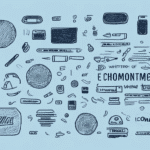A Comprehensive Guide to Direct-to-Consumer Fulfillment
Are you a business looking to sell your products online? If so, direct-to-consumer (DTC) fulfillment may be the right strategy for you. In this comprehensive guide, we'll explore what DTC fulfillment is, its benefits, how it works, factors to consider before implementing it, choosing the right fulfillment partner, best practices for managing it, common challenges and how to overcome them, technology and automation in DTC fulfillment, trends and innovations, and how to measure the success of a DTC fulfillment strategy. Finally, we'll look at the future of direct-to-consumer fulfillment, including predictions and opportunities for growth.
What is Direct-to-Consumer Fulfillment?
Direct-to-consumer (DTC) fulfillment is the process of shipping a product directly from a manufacturer or distributor to the end consumer, bypassing traditional brick-and-mortar retailers. This model allows businesses to have complete control over the customer experience, from product development to shipping and handling.
One of the main advantages of DTC fulfillment is the ability to gather valuable customer data. By selling directly to consumers, businesses can collect information on purchasing habits, preferences, and demographics. This data can then be used to improve marketing strategies and product offerings.
Another benefit of DTC fulfillment is the potential for higher profit margins. By cutting out the middleman, businesses can save on distribution and retail costs, allowing them to offer products at a lower price point or increase their profit margins.
The Benefits of Direct-to-Consumer Fulfillment
- Direct Customer Access: DTC fulfillment allows businesses to have direct access to their customers, providing invaluable data about consumer behavior and preferences.
- Stronger Customer Relationships: Businesses can build stronger relationships by offering a personalized experience and addressing customer needs in real-time.
- Faster Delivery Times: DTC often results in quicker delivery, enhancing customer satisfaction and reducing logistics costs.
- Control Over Brand Image: Handling the entire fulfillment process ensures that packaging and shipping align with brand values and standards, fostering trust and loyalty.
- Cost-Effective: Especially beneficial for startups, DTC can save on fees and commissions paid to third-party retailers or distributors, improving profit margins.
How Direct-to-Consumer Fulfillment Works
DTC fulfillment involves three main steps:
- Product Production: Manufacturing or sourcing the product.
- Warehousing and Logistics Management: Storing products in a dedicated warehouse and managing inventory.
- Shipping and Handling: Processing orders, packaging, and shipping directly to consumers.
By managing the entire fulfillment process in-house, companies can ensure that their products meet customer expectations and align with their brand values. Additionally, DTC fulfillment provides valuable data insights into customer behavior and preferences, informing future product development and marketing strategies.
Factors to Consider Before Implementing DTC Fulfillment
Implementing DTC fulfillment requires careful consideration of several factors:
- Target Market: Understanding your audience and their purchasing behaviors.
- Product Pricing: Setting competitive prices while maintaining profit margins.
- Fulfillment Capabilities: Assessing your ability to handle warehousing, shipping, and customer service.
- Inventory Management and Scalability: Ensuring you can manage inventory levels and scale operations as needed.
- Shipping and Handling Costs: Evaluating the costs associated with different shipping options and handling processes.
Additionally, consider the level of customer support required. Direct interactions with your brand necessitate robust customer service resources, such as a dedicated support team or chatbot technology. Clear policies for returns and exchanges are also essential to maintain customer satisfaction.
Choosing the Right Fulfillment Partner for DTC Operations
Choosing the right fulfillment partner is crucial for the success of your DTC strategy. Consider the following when selecting a partner:
- Experience in DTC Fulfillment: Ensure the partner has a proven track record in DTC operations.
- Reliability and Accuracy: Look for partners that provide dependable and precise logistics, storage, and shipping services.
- Technology Solutions: Partners should offer advanced technology and real-time data insights to optimize the fulfillment process.
- Scalability: The partner should be able to scale operations according to your business growth.
- Integration Capabilities: Ensure the partner can seamlessly integrate with your existing systems and platforms.
For example, Shipscience offers comprehensive DTC fulfillment services tailored to various business needs.
Best Practices for Managing Direct-to-Consumer Fulfillment
- Focus on Customer Experience: Prioritize a seamless and satisfying experience from order placement to delivery.
- Streamline Processes: Optimize processes for receiving and processing orders, as well as picking, packing, and shipping products.
- Regular Evaluation: Continuously assess and refine your fulfillment processes to meet customer needs and reduce costs.
- Utilize Technology: Implement software solutions for inventory management, order tracking, and data analysis.
Common Challenges in Direct-to-Consumer Fulfillment and How to Overcome Them
Common challenges in DTC fulfillment include:
- Inventory Management: Accurate tracking and management of inventory to prevent stockouts or overstocking.
- Order Processing: Efficient handling of orders to ensure timely and accurate deliveries.
- Shipping and Handling: Managing shipping logistics to balance speed and cost.
To overcome these challenges:
- Invest in inventory tracking systems and automated order processing tools.
- Partner with a reliable fulfillment service like Shipscience to ensure efficient logistics.
- Implement clear and user-friendly return policies, providing prepaid return labels and timely refunds or exchanges.
Maintaining customer satisfaction and loyalty is also essential. Offer personalized communication, fast and reliable shipping, and incentives such as discounts or loyalty programs to build a loyal customer base.
Technology and Automation in DTC Fulfillment
New technologies, such as automation and robotics, are transforming DTC fulfillment:
- Automation: Streamlines processes, reduces costs, and improves accuracy and speed.
- Cloud-Based Platforms: Optimizes logistics and enables real-time, data-driven decision-making.
- Scalability: Automation allows businesses to handle increased demand without significant additional resources.
According to a Logistics Management report, businesses that implement automation can increase order accuracy by up to 99% and reduce fulfillment costs by 30%.
Trends and Innovations in DTC Fulfillment
- Subscription-Based Models: Increasing popularity of meal delivery services and subscription boxes.
- Social Media Integration: Leveraging platforms like Instagram and Facebook to reach and engage customers.
- Data Analytics and AI: Utilizing analytics and artificial intelligence to understand customer behavior and optimize fulfillment processes.
- Eco-Friendly Packaging: Adoption of sustainable materials such as biodegradable plastics and recycled paper.
- Advanced Delivery Options: Exploring drones and autonomous vehicles for faster and more efficient deliveries.
These innovations not only improve operational efficiency but also enhance the customer experience, making businesses more competitive in the DTC market.
Measuring the Success of a Direct-to-Consumer Fulfillment Strategy
To evaluate the effectiveness of your DTC fulfillment strategy, monitor the following key performance indicators (KPIs):
- Order Accuracy: The percentage of orders correctly fulfilled without errors.
- Speed of Delivery: The average time taken from order placement to delivery.
- Customer Satisfaction: Measured through reviews, ratings, and feedback surveys.
- Logistics Costs: Total costs associated with warehousing, shipping, and handling compared to industry benchmarks.
- Return Rates: The percentage of products returned, indicating potential issues with product quality or descriptions.
- Inventory Turnover Rate: The rate at which inventory is sold and replaced over a period.
Regularly analyzing these metrics allows businesses to identify areas for improvement, optimize their fulfillment processes, and ensure efficient operations.
Future of Direct-to-Consumer Fulfillment: Predictions and Opportunities
The future of DTC fulfillment is poised for significant growth and innovation:
- Automation and AI: Continued advancements in automation and artificial intelligence will further streamline fulfillment processes.
- Subscription Models: Expansion of subscription-based services across various industries.
- International Expansion: Opportunities for businesses to reach global markets with efficient international fulfillment solutions.
- Sustainability: Growing demand for eco-friendly fulfillment practices, including sustainable packaging and carbon-neutral shipping options.
- Omnichannel Integration: Seamless integration of online and offline fulfillment channels to provide a unified customer experience.
As the e-commerce market continues to expand, businesses that adopt innovative DTC fulfillment strategies will be well-positioned to capitalize on new opportunities and achieve sustained growth.
In conclusion, DTC fulfillment offers numerous benefits, including direct customer access, faster delivery times, and improved profit margins. However, successful implementation requires careful planning, the right partnerships, and the adoption of advanced technologies. By following best practices and staying abreast of industry trends, businesses can overcome common challenges and thrive in the competitive DTC landscape.
One of the key trends in DTC fulfillment is the increasing demand for sustainable and eco-friendly practices. Consumers are becoming more conscious of the environmental impact of their purchases, and businesses that can offer sustainable packaging, shipping, and fulfillment options are likely to gain a competitive edge. This includes using biodegradable materials, optimizing shipping routes to reduce carbon emissions, and implementing recycling programs. By prioritizing sustainability in their DTC fulfillment strategies, businesses can not only appeal to environmentally conscious consumers but also reduce their own environmental footprint.






















